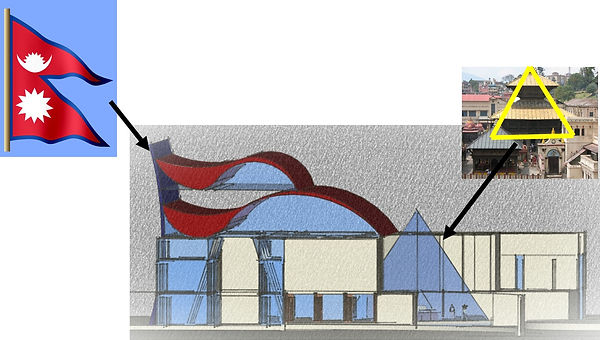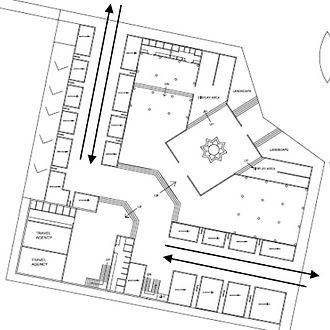Temporal Diffusion Plane
Fall 2017 | Light and Sustainable Design | Prof. Matt Fajkus
Three and a half stories residential building for a family of three members was designed and constructed at Kathmandu, Nepal. Rcc structure with ground and first floor as a rentable space were conceptualized taking solar exposure into considerable. Kathmandu with a monsoon climate has four different seasons: Winter, Summer, Rainy, and Spring. So the building is designed in such a way that it has the highest solar exposure during winter while during summer the building is well shaded. Moreover, shading from the rain is also taken into consideration. The architecture style of the Kathmandu valley is studied and the building is conceptualized which shows respect towards the surrounding contemporary style.
Three and a half stories residential building for a family of three members was designed and constructed at Kathmandu, Nepal. Rcc structure with ground and first floor as a rentable space were conceptualized taking solar exposure into considerable. Kathmandu with a monsoon climate has four different seasons: Winter, Summer, Rainy, and Spring. So the building is designed in such a way that it has the highest solar exposure during winter while during summer the building is well shaded. Moreover, shading from the rain is also taken into consideration. The architecture style of the Kathmandu valley is studied and the building is conceptualized which shows respect towards the surrounding contemporary style.
Three and a half stories residential building for a family of three members was designed and constructed at Kathmandu, Nepal. Rcc structure with ground and first floor as a rentable space were conceptualized taking solar exposure into considerable. Kathmandu with a monsoon climate has four different seasons: Winter, Summer, Rainy, and Spring. So the building is designed in such a way that it has the highest solar exposure during winter while during summer the building is well shaded. Moreover, shading from the rain is also taken into consideration. The architecture style of the Kathmandu valley is studied and the building is conceptualized which shows respect towards the surrounding contemporary style.
Temporal Diffusion Plane
Fall 2017 | Light and Sustainable Design | Prof. Matt Fajkus
Project partners: Rob Manion, Elijah Montez, Shani Saul
Temporal Diffusion Plane
Fall 2017 | Light and Sustainable Design | Prof. Matt Fajkus
Project partners: Rob Manion, Elijah Montez, Shani Saul
Perforations on the building envelope are designed to reflect the changing seasons and subsequently the changing quality and angle of natural light. Made of Ductal high-performance concrete the façade is either fully open to allow full light into space or punctured in a pattern that creates an interesting and dynamic light that moves as time passes.
Light historically has governed our days. Long before the existence of “artificial” light, the sun was the driving force behind all human activity. Today, daylight affords numerous biological, emotional, and perceptual advantages to the human body that are unmatched by artificial lighting mechanisms. Architecturally, natural light has the ability to connect us with the present moment and encourage an increased awareness of our environment. It reminds us of the passage of time by infusing the material world with that of the ephemeral, and in doing so, harmonizes the user with the natural world. As light is redefined through the passage of time, the experiential quality and use of its respective spaces shifts as well. A sustainable built environment will focus on harvesting and honoring the ephemeral quality of natural light to reengage the human body and mind.
Perforations on the building envelope are designed to reflect the changing seasons and subsequently the changing quality and angle of natural light. Made of Ductal high-performance concrete the façade is either fully open to allow full light into space or punctured in a pattern that creates an interesting and dynamic light that moves as time passes.
Light historically has governed our days. Long before the existence of “artificial” light, the sun was the driving force behind all human activity. Today, daylight affords numerous biological, emotional, and perceptual advantages to the human body that are unmatched by artificial lighting mechanisms. Architecturally, natural light has the ability to connect us with the present moment and encourage an increased awareness of our environment. It reminds us of the passage of time by infusing the material world with that of the ephemeral, and in doing so, harmonizes the user with the natural world. As light is redefined through the passage of time, the experiential quality and use of its respective spaces shifts as well. A sustainable built environment will focus on harvesting and honoring the ephemeral quality of natural light to reengage the human body and mind.
Mandir
2016 | Volunteering Work
Mandir
2016 | Volunteering Work
Nepal Tourist Center
2014 | All Nepal Architecture Student Design Competition | SONA
Consolation Prize Winner Design
Nepal Tourist Center with facilities of Restaurant, Travel Agencies, Government immigration office, Shops, and the auditorium is designed for Kathmandu, Nepal. The site is located in the capital city of Nepal. This project is imagined to provide a platform for tourist where they can find government offices and agencies they needed for trekking in Nepal under one roof. Representing the old settlement with shops of either side and walkway in between, this center is conceptualized to replicate the old settlement pattern of Kathmandu. Along with that, the unique shape of the national flag of Nepal is abstracted to give the iconic look and identify to the building.

Site Analysis

LOCATION:
Tri Devi Marg, Thamel, Kathmandu, Nepal
AREA:
25273.66 SQ FT
PHYSICAL FEATURE:
27°42’54.56” N And 85°18’36.79” E
ACCESS AND APPROACH:
7 m wide metallic road approaching to a site in both east and north
LAND USE:
25% of the site is used by travel agencies (8 in nos.) and merchandise while the rest site is used for parking.
CLIMATE:
Monsoon climate
TEMPERATURE:
Mean MAX TEMP. 29-32 C , Average MIN. 12-14 C
SITE SURROUNDING:
Private building on the south with election commission nearby, SAARC building on the west. Garden of Dream and Kesar Library on the north, US recreational club on east and Narayanhiti museum on east-north.
Concept
RENDERINGS


•MERCHANDISE IN EITHER SIDE REFLECTING THE TRADITIONAL MERCHANDISE AREA
•VEHICLUAR FREE PEDESTRIAN WALKWAY IN MIDDLE

